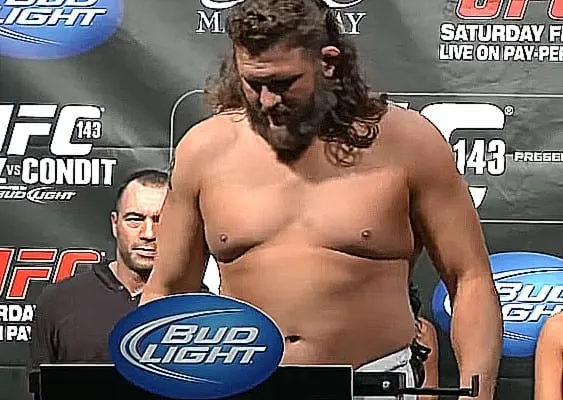
If you ever wonder about UFC heavyweight division, it seems logical to think that UFC heavyweights should not have any weight limits because the heavyweight division is created for the heaviest fighters. But, contrary to popular belief, UFC heavyweight division has a weight limit. There are actually good reasons why there’s a weight limit in the heavyweight division.
The weight limit rule for UFC heavyweight fighters was put in place to ensure the safety of heavyweight fighters by forcing them to stay in shape, which leads to better performance when they compete in the octagon.
The upper weight limit for the UFC heavyweight division is 266 pounds (non-title fights), or 265 pounds if the title is on the line.
Fighters who weigh near 300 pounds or more, in most cases, have a lot of body fat, bad cardio, and are prone to injuries. On top of that they look slow, are less skilled than lighter heavyweights, and tend to gas quickly. Allowing 300+ pound fighters to compete would lead to a lot of freak show fights that are not entertaining to watch and won’t generate huge pay-per-view sales. In fact, these fights might even have a negative impact on the image and reputation of the company in the long run.
Why Does UFC Heavyweight Division Have A Weight Limit?
The UFC is a leading combat sports promotion that wants to portray its product as a high-level sport that is home to only the finest athletes. Therefore, the upper weight limit of 265 pounds is there to force overweight fighters to lose weight, get in shape, and work on their conditioning.
This doesn’t mean that they are going to look athletic and muscular. No, fighters like Mark Hunt, Tai Tuivasa, or Derreck Lewis would still look chubby. But the 265 lbs limit forces them to cut extra weight and get in good shape, which has a positive impact on how they perform on fight night. Or in other words, the limit improves the quality of the matches and here is one good example how.
Most modern heavyweights are capable of going through a 3 round war. Some of them can also fight a high pace fight for five full rounds, like Stipe Miocic and Daniel Cormier did at UFC 252. On the other side, fighters who weigh 300 pounds or more would likely gas out after just a couple of minutes. And when you have two of them fighting each other, you get a pure freak show in most cases.
Most fighters who are above 265 pounds and over 300 pounds do not have great conditioning, look unathletic, and do not last long in a fight. On top of that, carrying that much weight makes you slow, less explosive, and with that, less skillful than fighters who stay at a reasonable weight.
For last, fighters who weigh more than 300 pounds are, in a lot of cases, not as healthy. Carrying this amount of weight impacts your overall health and these fighters are not reliable and are more prone to injuries.
Why Does It Have To Be a 265lbs Limit? Why Not Raise It?
The reason why the athletic commission set the upper weight limit to 265 pounds is not clear. But, it is most likely because this specific weight represents an ideal balance between different factors. First, this weight limit is large enough so that most big heavyweights can go through weight cuts and make the weight without negatively impacting their health or performance on fight night.

If the fighter can’t drop down to 265 pounds, they are most likely out of shape, overweight, and unhealthy. 265 pounds is the weight where most big fighters still feel strong and have good cardio.
Why Is There No Super Heavyweight Division In The UFC?
There are two most likely reasons why the UFC doesn’t have the super heavyweight division.
1) Quality of Fights:
Heavyweight fighters weighing close to 300 pounds or more are not as healthy as the fighters who maintain, let’s say 265 pounds. These fighters who weigh more than 265lbs are likely much slower, less explosive, and overall, less skilled, and if you combine that with the lack of conditioning, you get freak shows that do not have a lot of to offer in terms of entertainment value. Even if they don’t get tired, these fighters would not amaze the crowd with a high level of technique simply due to the lack of athleticism.
2) Lack of Skilled Super Heavyweights:
There are potential super heavyweight fighters who look like monsters and can put on a great show for the fans, but not enough. If the UFC adds super heavyweight division, they would need at least 15-20 talented fighters to fulfill their roster, and there are simply not enough top-level super heavyweight fighters out there.
The UFC is always looking for ways to improve the quality of its product and increase talent. But adding a super heavyweight weight class won’t help them much in achieving this goal.
What Is The Minimum Weight For A UFC Heavyweight?
Yes, the minimum weight for the heavyweight division in the UFC is 205 pounds. Fighters who compete in the heavyweight division must weigh from 205 pounds to the upper weight limit which is 265 pounds. They are not allowed to weigh less than 205 pounds, because in that case, they belong in the light heavyweight division which ranges from 186 pounds to 205 pounds. And, they can’t go above 265 pounds because the UFC doesn’t include the super heavyweight division. They must weigh anywhere between 205 and 265 pounds.
What Is The Maximum Weight For A UFC Heavyweight?
The heaviest you can step on the scale in the UFC is 266 pounds for the heavyweight division, and that is the case only if it is a nontitle match. If a championship is on the line, then both fighters need to weigh 265 pounds or less during the official weighing-ins a day before the fight.
But, you can weigh more on the fight night after you make weight for a weigh-in. Some big heavyweights like Greg Hardy go through a weight-cutting process to hit the scale at 265 pounds on weighing ins. But, they have around 24 hours left until the fight starts and they can use this time to gain the lost weight back. So once they enter the cage on fight night, these fighters could weigh 280 pounds or even more than that.
Has A UFC Heavyweight Ever Missed Weight?
Yes, the first ever heavyweight fighter who failed to weigh at the upper limit of 265 pounds was Justin Tafa who is one of the biggest heavyweights. A day before his bout against Harry Hunsucker at UFC Vegas 45, Tafa stepped on the scale weighing 267 pounds. The commission gave Tafa an extra hour to cut just 1 pound, but he failed to do so. This way, Tafa became the first heavyweight fighter to miss the weight.
The fight was still on, however, as Hunsucker agreed to a catchweight fight at 267 pounds. But, Hunsucker ended up being knocked out with a wild head kick in the second minute of the fight.
The other fighter who nearly missed weight was the former NFL star, Greg Hardy. Leading up to his bout against Maurice Green at UFC Vegas 12, Hardy missed the weight in his initial attempt. But he used an extra hour to cut the extra weight and meet the 265 pound limit in the second attempt.
What Happens When UFC Fighters Miss Weight?
When a UFC fighter misses weight, the commission overlooking the event would give him/her an hour to cut extra weight and meet the upper limit for that specific weight class. Although this is a grueling process, an hour is often enough for a fighter to cut 1 or 2 extra pounds. There have been many fighters who used this extra hour to make weight in the second attempt.
If they fail in their second attempt, this doesn’t mean that the fight is canceled straight away. No, the UFC would in that case ask their opponent to agree to a catchweight fight, and the athletic commission needs to approve that. If both the opponent and commission agree, the fight is still on. But, a fighter who missed weight would be fined 20% of their purse, or even 30% if they missed the weight by a lot. And this amount of money would be awarded to the opponent who made weight and agreed to fight at catchweight.
But losing 20% or 30% is not the only bad thing about missing weight. This is very unprofessional and it has a negative impact on fighters’ relationship with the UFC. The UFC would start looking at them as unreliable, and with that, give them fewer opportunities in the future.
RECOMMENDED FOR YOU: What is Catchweight in UFC? Simply Explained
Do Bellator MMA, One Champinship, And PFL Have Heavyweight Limits?
Yes, most other MMA promotions like Bellator, ONE Championship, and PFL have the same upper weight limit for the heavyweight division as the UFC. In fact, the super heavyweight division has never been endorsed by any major promotion. One minor promotion that has super heavyweight weight class is “King of the Cage”.
In the past, promotions like DREAM and PRIDE FC had open weight divisions where there was no upper weight limit for a heavyweight weight class. Even the early days of UFC used to hold open weight matches back in the early 90s.
RECOMMENDED FOR YOU: What Happened to PRIDE Fighting Championships?
Related Questions
Do UFC Fighters Get Paid If The Fight Is Canceled?
UFC fighters do not get paid their show money if their fight gets canceled, according to UFC president, Dana White. If the fight falls apart a month or a couple of weeks before the event, fighters won’t get paid. However, the story is a bit different if the fight gets canceled a day before the event because one of the fighters missed weight. In that case, the UFC is known to pay the fighter who made weight but can’t fight. But how much money the fighter gets paid in that situation is not clear as the exact amount is not released to the pubic.
But what happens if the fight gets canceled weeks before the event?
If one of the fighters pulls out weeks before the fight, fighters won’t get paid. Instead, UFC would offer them a replacement or try to rebook the fight in the future.
How Do UFC Fighters Cut Weight?
UFC fighters start the weight cutting process in training camp, a month or two before the fight. But, they lose the majority of their weight, close to 20 pounds, in the last week before the fight. Here is a brief look at the entire process of weight cutting.
Fighters start the fight week by carefully decreasing the water consumption because this is the fastest way to lose a lot of weight. In the last two days before the weighing ins, they would barely drink any fluid at all, which is why fighters look drained standing on the scale. It’s also important to decrease sodium intake because this helps fighters flush the water out more efficiently.
Next, they would also reduce the number of carbs per day to around 50 grams, and also avoid eating fruit, sugar, and starches. Instead, they are allowed to eat food rich in protein like meat or eggs, and vegetables like broccoli or cauliflower, but not much.
Like that’s not hard enough, fighters need to stay active, take hot baths, sit in the sauna, and even run on the treadmill. According to many fighters, cutting weight is much harder than fighting inside the cage.
RECOMMENDED FOR YOU: Top 10 Reasons Why MMA Is The Hardest Sport
Why Don’t UFC Fighters Fight At Their Normal Weight?
There are two main reasons why UFC fighters don’t fight at their normal weight. First, fighting below their normal weight gives them a big size advantage. The second factor you need to consider is that, in modern MMA, every single fighter is going through a weight-cutting process. What is the point of cutting weight if everybody is doing it?
Well, if you decide to fight at your normal weight, let’s say 170 pounds, you would compete against fighters who weigh close to or even more than 190 pounds on fight night. These fighters would cut the weight to hit the scale at 170 pounds and then gain 15 or 20 pounds back in less than 24 hours. Once you enter the cage, you would have to compete against an opponent who is physically bigger and 20 pounds heavier than you are.
So as long as the weight cutting exists in MMA, fighters would continue to cut weight. Let’s take the UFC fighter, Paulo Costa, as an example here.
Costa is a fighter who walks at around 220 pounds. If he decides to fight at his normal weight, he has to compete in a heavyweight division. Here, Costa would have to deal with much bigger and stronger opponents who are 260+ pounds in weight, and in most cases, get destroyed. It would be really hard for him to deal with the fighters like Francis Ngannou. He might get a win or two, but would never enjoy the same success as in the 185-pound division where he is likely to have a size advantage over other 185 pound fighters.
RECOMMENDED FOR YOU: Why Are MMA Fighters Skinny And Don’t Have Big Muscles?
How Heavy Is Brock Lesnar?
Brock Lesnar weighs around 286 pounds (130kg) and is 6″3′ tall (191), all solid muscles. He is a mountain of a man and probably the most intimidating heavyweight fighter in the history of MMA. Back when he was fighting in the UFC, he was one of those big fighters who needed to cut weight down to 265 pounds. However, after the weighing-ins, he would have 24 hours left until the fight, and he used this time to gain some weight back. So on fight night, Lesnar would probably enter the cage weighing around 280 pounds or more.
